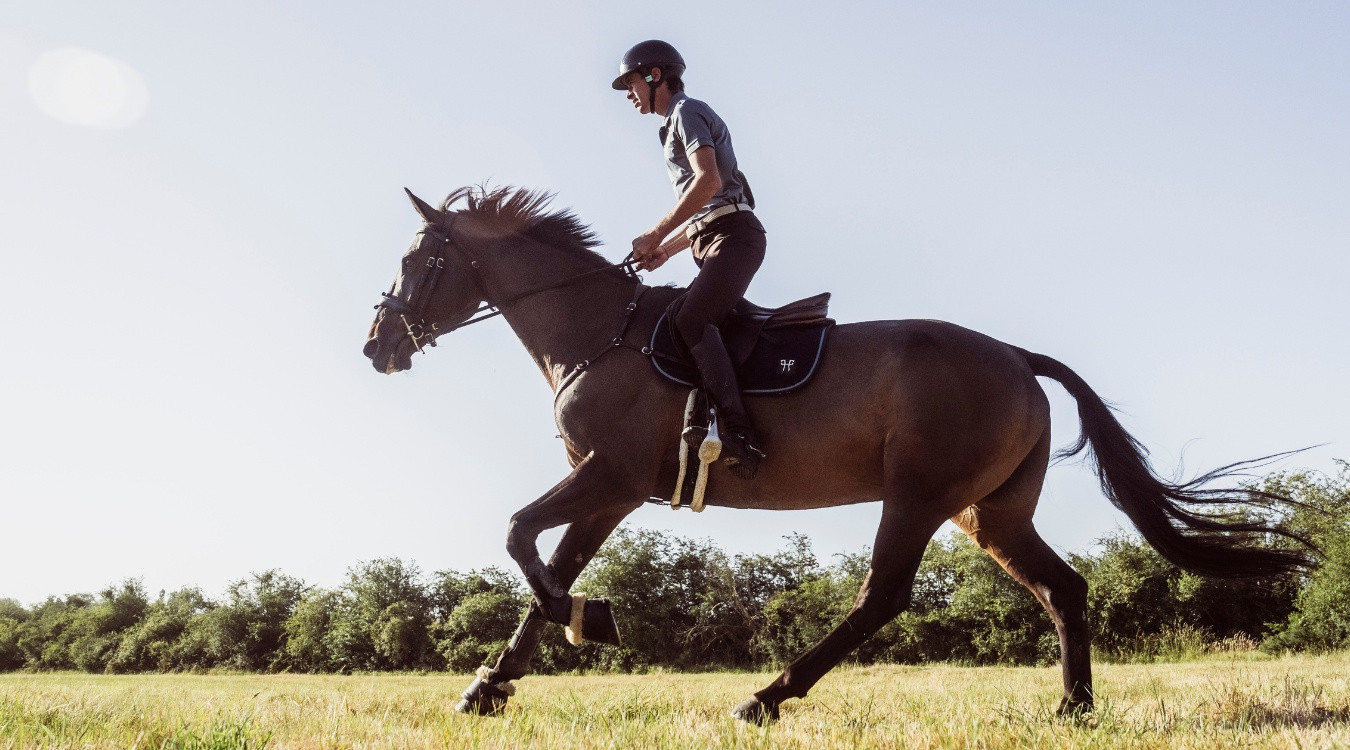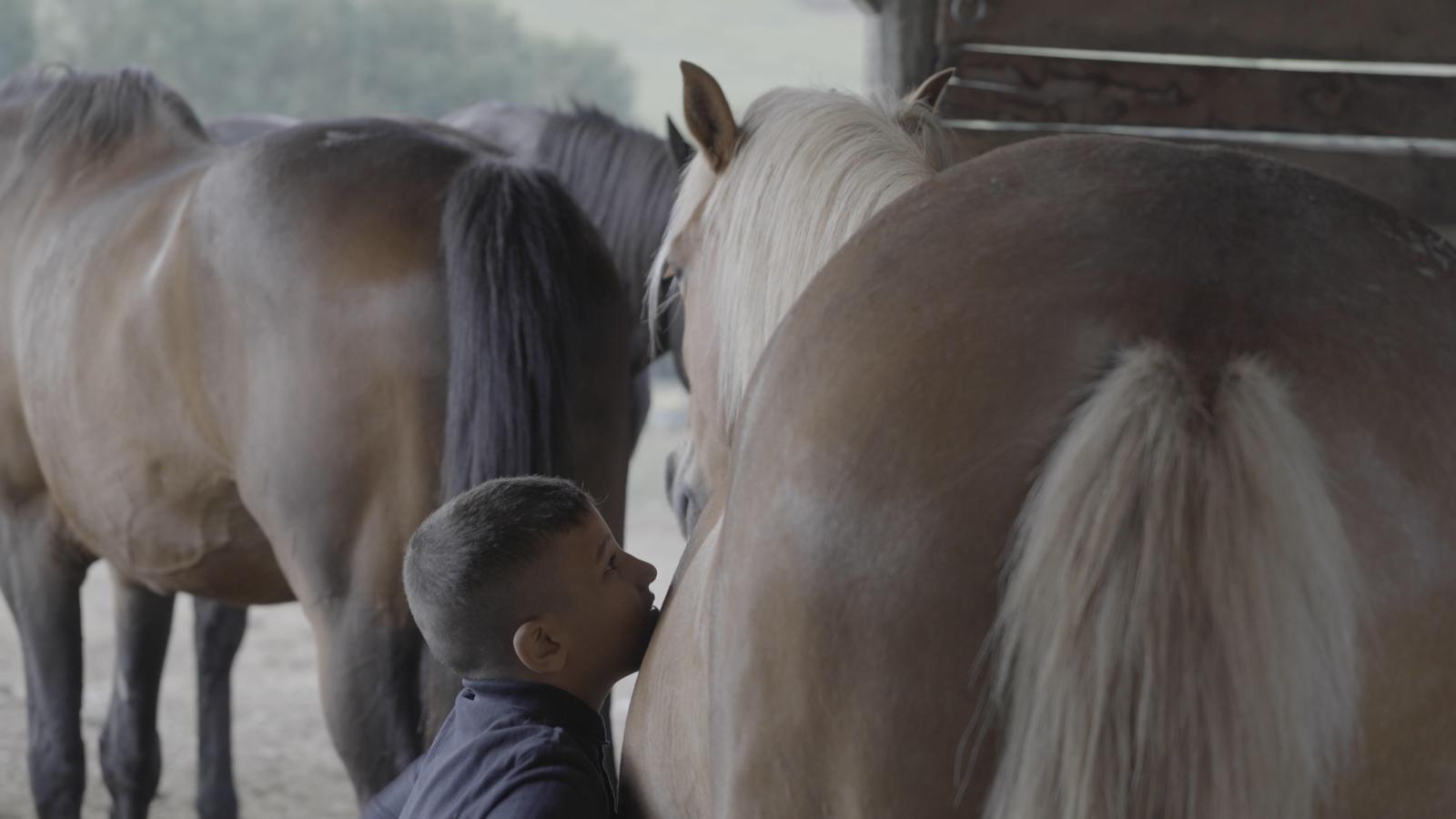
Meet a professional rider and trainer
Maxime Livio is a top-level event rider. He has been French number 1 for 12 years and is in the world top 20. Maxime runs a stable near Saumur. The stable has 70 horses, including top-level sport horses, commercial horses and student horses, from amateur to top level. Maxime Livio is also the trainer of the Thailand team, which has been based at the stable for some ten years.
Here, Maxime Livio shares his expertise and advice on how to optimize a horse’s cardio work, improving its ability to sustain effort, recover quickly and excel in all equestrian disciplines.
The benefits of cardio in all disciplines
The horse’s cardiovascular system
Horse Pilot : What are the particularities of the horse’s cardiovascular system?
Maxime Livio : Just as in humans, there are links between movement, heart rate and breathing in horses. In the gallop, breathing is based on the rhythm and mechanics of the stride. Horses breathe in and out over the time of a galloping stride, which has an impact on the way they recover. A horse with repeated short strides will breathe faster, and therefore have a faster heart rate. A horse with a long stride will have a slightly higher heart rate and endurance.
Cardio training for horses
HP : Why is it essential to work on your horse’s cardio?
M.L. : The heart is a muscle and, as in the case of human beings, it is essential to train it to increase its capacity to handle increasingly large work amplitudes. Training enables the heart to move from rest to work and then to recovery, always functioning optimally.
In horses, as in humans, emotions have an impact on heart rate. Some horses may have a slightly abnormal heart rate in relation to the exercise they are doing. This may be due to surprise, as when a doe is encountered on the galloping track, or to a new situation, as when a young, emotional horse takes its first cross-country course.
Cardio training must therefore be very gradual, taking into account these different aspects which can disrupt its functioning.
HP : How does this work influence the horse’s performance in the various equestrian disciplines?
M.L. : The key to horsemanship lies in the balance of the rider’s actions, because they have repercussions on the horse’s actions. When the horse is stressed, its heart rate increases, and this inevitably has consequences. For example, errors at the end of a course or in a recovery are often due to a lack of oxygenation in the brain, combined with tiredness and an increased heart rate. The rider’s actions can then be a little more abrupt, resulting in a certain amount of tension. Progressive, regular training in all disciplines is therefore essential to ensure that horses are mentally, muscularly and cardio-trained for the level they are to perform at.

What we want to work on
The main objectives
HP : What are your main objectives in working on your horses’ cardio?
M.L. : The aim is to gradually develop endurance under stress. First, it’s essential to teach the horse how to work his body properly. The horse’s biomechanics then come into play. Muscles work harder, demanding more blood and oxygen. The aim is to develop the aerobic and anaerobic pathways in parallel, meaning endurance and power, to enable horses to take on longer and more intense effort.
Personalize your horse’s cardio training
HP : How do you adapt cardio training to each horse’s individual needs?
M.L. : In my opinion, training should be adapted to each horse’s personality. For example, an introverted horse will need to be trained regularly on a level that is easy for him, so that he gains confidence and becomes aware of his potential. Conversely, a very self-confident horse will need to be trained on exercises that are intense in technical difficulty, but rather short so as not to annoy him.
Cardio training must also take into account the horse’s intrinsic potential. In the case of naturally fast, energetic horses, the aim is to teach them to channel their energy to keep up over time. They should therefore be offered long, slow training sessions. Conversely, horses with stamina and a single speed will need to work on split canters to change pace regularly. Change of pace is important for these horses, because if they don’t get tired, they won’t progress.
Medical follow-up to monitor the effectiveness of cardio work: heart, lungs, heart rate…
HP : What medical parameters do you monitor to adjust your horses’ cardio training program?
M.L. : Medical monitoring takes place at different levels. When the horse is in action, we check its heart rate using a heart rate monitor. Personally, I find that this tool somewhat disconnects the rider from his sensations, which in my opinion are more relevant for assessing the horse’s condition at the time. On the other hand, these data are important because they are then collected by various vets who help me to analyze them.
Medical monitoring during exercise is used to assess the effectiveness of training. The aim is to reduce heart rate and recovery time without reducing work intensity.
Regular monitoring of the respiratory system is also part of medical care. Horses are never at 100% of their respiratory capacity, but this can be improved with small treatments administered by nebulization or orally. These treatments enable horses to gain between 5% and 15% of their respiratory capacity, and give them a boost in sustaining effort.
Another important aspect of medical monitoring concerns feed. Feed quality influences the way it is digested and assimilated, and therefore has a direct impact on the horse’s cardiovascular performance.
Finally, the tack is also carefully monitored. During exercise, some horses suffer from dry mouth, which can affect the quality of their breathing. To help these horses, I put a little paraffin oil in their mouths just before going out on a cross-country run. This keeps their mouths very moist, enabling them to maintain a good relationship with their mouthpiece and breathe better.
Medical care therefore encompasses many aspects, all of which are important and which considerably increase the cardio potential of horses.

Work protocol and exercise variations
Number of sessions
HP : How many sessions a week do you recommend to effectively develop and maintain your horse’s cardio?
M.L. : This depends on the discipline and the level of competition. As a general rule, no more than 2 leg-loading sessions per week (jumping, cantering) are required, ideally spaced 4 days apart. Depending on the event level, the canter can be replaced by trotting, which is not considered a leg-loading exercise. It’s the equivalent of jogging, the aim of which is not to develop physical fitness, but merely to maintain it. My top-level horses do one trotting and one canter a week. The day after a jumping session, we take the horses trotting to clear their heads and get them out of the arena. On the remaining days, we do dressage.
Duration
HP : How long do these sessions have to last to be effective?
M.L. : This depends on the level of the event, but there are a few rules to follow. For example, for a complete recovery, the trot time after a canter should be one to two times the cantered time. As far as warm-up is concerned, where we train our horses, we’re lucky enough to have a small, fairly steep hill. At the start of training, we trot the horses up and down this hill for 15 to 25 minutes, depending on the event we’re preparing. This is a very interesting exercise, as it gets the cardio up without putting too much strain on the legs or body.
It’s important to remember that prolonged fast galloping is not without risk to the horse’s health. It’s better to gallop at a reasonable pace, with occasional accelerations, than to gallop for long periods at high speed.
The only way to increase cardio without speeding up is to make the work more arduous, which means riding on a hill or deep ground. When we go to Granville to gallop the French team’s horses before a deadline, we choose the ground according to the effort we’re looking for. The deeper the ground, the harder the horse has to work, which increases the heart rate without the need to accelerate.
The standard protocol
HP : What is your standard protocol for regular cardio training of a horse?
M.L. : Our horses’ daily routine at home is fairly repetitive, which allows them to get into condition naturally. They start with a 30-minute walk in the morning, followed by a work session lasting between 30 and 45 minutes, whatever the discipline. They then spend a few hours in the paddock, followed by another 30-minute walking session. The day ends with a treatment session.

Maxime Livio’s targeted protocol
HP : Can you describe a targeted training protocol to develop your horses’ cardio in preparation for competitions?
M.L. : Once you’ve reached a certain level of performance, you can add one or more trotting sessions to the standard protocol, or one trotting session and one canter every week. Training should always be progressive and increase in intensity. For example, I started galloping my horses in January to prepare for an event in March. The aim of the first canters was simply to get the horses’ bodies used to changing speed again, after spending 6-8 weeks at home doing short trots and working in the arena. Subsequent gallops were a little longer, but still effortless. Today, a month after the start of the recovery, we can see that the horses’ bodies and minds are capable of taking on a greater effort. So we’re going to increase the variation in speed and gradient a little to get the cardio up and start working the horses with the aim of making them progress. The idea is to bring the horses to the best of their physical condition without ever going overboard. It’s a question of finding the right balance, and you shouldn’t hesitate to ask your trainer for a personalized protocol to suit your objectives.
The variation of the exercices
HP : Why is it important to vary the exercises on offer?
M.L. : Because it’s more fun! What we offer in eventing is so varied that horses enjoy switching from one discipline to another. That’s why I think the diversity of exercises is important in all disciplines. A horse that has cleared its head will be more available for dressage the following days. Likewise, a show jumping horse who has been competing one competition after another will be happy to take a break by putting his feet in the water or going for a walk in the forest. He can then trot or canter again, before returning to the show ring in good physical and mental condition.
Varying the exercises is also physically useful, as it enables horses to feel at ease on all types of ground, whether grass, sand, uphill, downhill, deep or firm.
Complete focus with exercise ideas: outdoors, in the arena…
HP : Could you share some specific exercises, both outdoors and in the arena, that are particularly effective for working the horse’s cardio?
M.L. : In the arena, I like to canter for a long time, between 8 and 12 minutes, by linking, for example, a straight line, a little faster, where I’ll go into suspension, and a turn where I’ll sit down to force the horse to grow and gather. It’s always important to balance the work in each hand. You can also work on changes of foot, as this forces the horses to stay focused. Canter work in the arena allows you to reproduce show conditions at a slower speed, and gets horses used to staying attentive for long periods.
Outdoors, we work on uneven ground, practicing going up and down at a trot or canter, ground permitting. This exercise teaches horses to push on the way up, and to hold and balance on the way down. In this way, the horses are trained in the same way as they would be on the flat, with the difference that here they are responding to a constraint inherent in the gradient and not to a request from the rider. In this way, they gain a certain amount of experience that will serve them well in future competitions.

Recovery
The importance of the recovery phase in cardio training for horses
HP : Why is the recovery phase crucial to optimize a horse’s long-term health and performance?
M.L. : After a heavy effort, recovery is very important, because it removes lactic acid from the muscles and thus prevents muscle soreness and stiffness, which can lead to various problems such as tendonitis. The longer and more gradual the recovery, the less impact the effort will have.
At the end of cross-country training, there are two types of recovery. Active recovery consists in trotting the horses for a long time, then walking them, to gradually lower the cardio level. The other type of recovery involves lowering body temperature by wetting the horse with cool water, then walking it. With this method, the heart rate drops more quickly, which is very useful during competitions when recovery time needs to be optimized.
Last but not least, recovery also includes all the little local treatments to be carried out on the legs. In particular, cold is applied to the feet, cannonballs, pasterns, tendons and even the knees, depending on the horse. After the cold, I also use clay, which I leave to dry on the legs to tighten tissues that have dilated during exercise. Recovery must enable the horse to return to its maximum level of well-being as quickly as possible, so that it can resume another effort a few days later.
Evaluation of recovery efficiency
HP : How do you evaluate the efficiency of a recovery session?
M.L. : Sweating is a good way to judge the intensity of effort. On the same canter, you can have a horse that doesn’t sweat and another that sweats a lot. The amount of water horses drink after recovery tells us how much water they’ve lost during the effort. What’s more, the speed at which horses dry out enables us to assess the quality of their breathing.
Rehydration is therefore essential to the horse’s muscular and physical recovery. To evaluate whether a horse is sufficiently rehydrated, you can take and release a fold of skin on the neck: if the skin is elastic and tightens immediately, the horse is rehydrated. If it takes a little longer to tighten, or if the fold persists, the horse is dehydrated.
Other parameters enable us to evaluate the effectiveness of the recovery. These include the color of the mucous membranes, the liveliness of the eyes, the brilliance of the coat and the horse’s attitude. A horse that has recovered well is a horse that is as alert as usual.

To remember : Horses’ physical condition and endurance are directly linked to the efficiency of their cardio-respiratory system. To achieve optimum performance, it is therefore essential to train the heart to cope with intense, prolonged effort, and to increase respiratory capacity. Progressive and regular cardio training enables horses to reach their full athletic potential, while preserving their long-term health.
—
We are proud to count Maxime Livio among our ambassadors & athletes Horse Pilot and that we’ll be supporting him in his projects. Thanks to him for sharing his experience with us.
Photos credits: Stephane Cande


